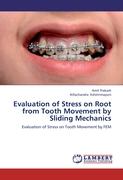Evaluation of Stress on Root from Tooth Movement by Sliding Mechanics
BücherAngebote / Angebote:
This finite element study was conducted to calculate the distribution of stresses on root surfaces when a orthodontic force of 2N was applied at different degrees namely 0 degree, 30 degree and 45 degree to the horizontal plane. An in-vitro finite element method was used to construct a three dimensional finite element model of a mandibular arch (without first premolars). Mechanical properties like Young's modulus of elasticity and Poisson's ratio were assigned to the model. To this model an orthodontic force was applied at various degrees on the crown of the tooth model. After the application of the forces initial stress on the root surface of mandibular anterior teeth was evaluated. The greatest amount of the maximum level of stress was found at the cervical margin of the PDL at all tooth roots, while the maximum stresses occurred at the root crest region of the canine among them. Bodily movement and tipping forces produce stress concentrated at the alveolar crest and not at the root apex This 3-dimensional model is a useful example to investigate the biomechanics of dental movement analyzing the mechanical stress on root surfaces.
Folgt in ca. 5 Arbeitstagen




